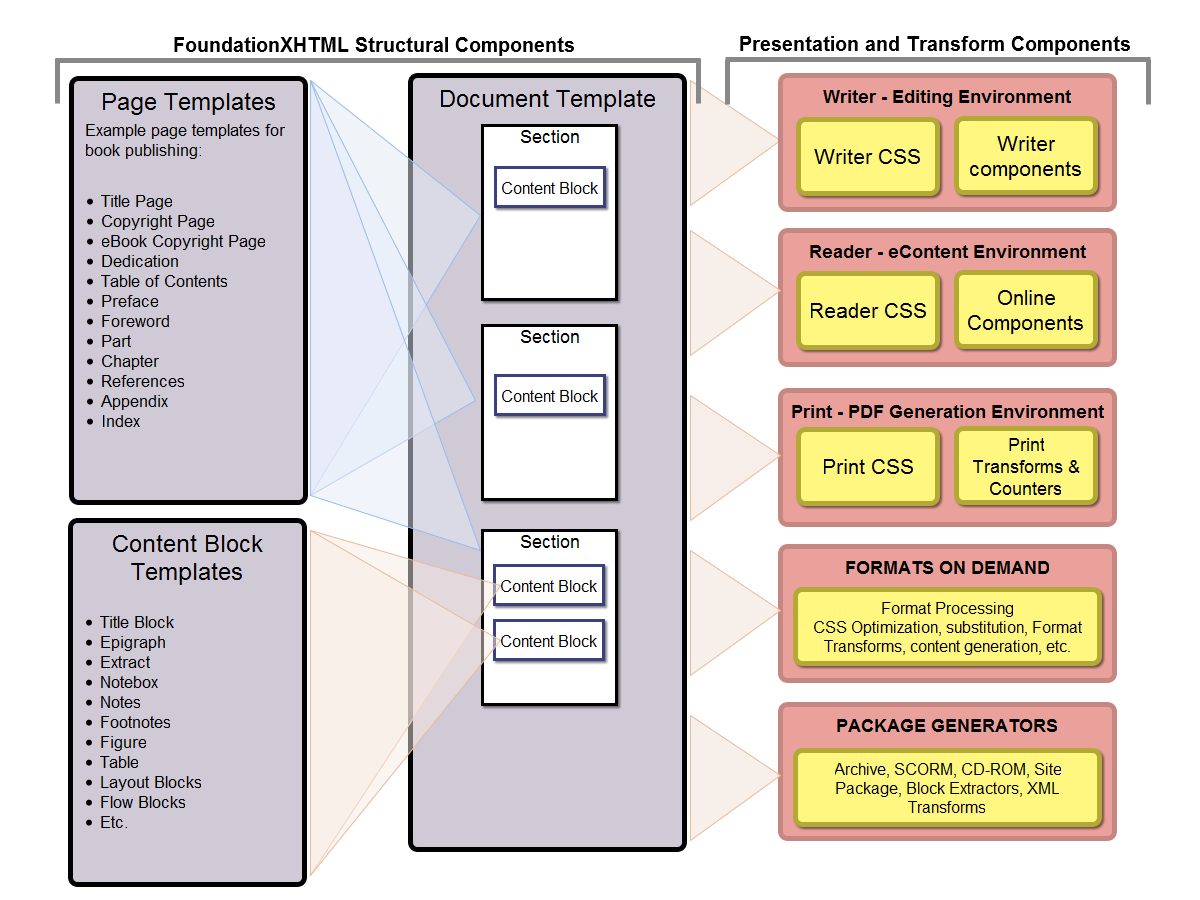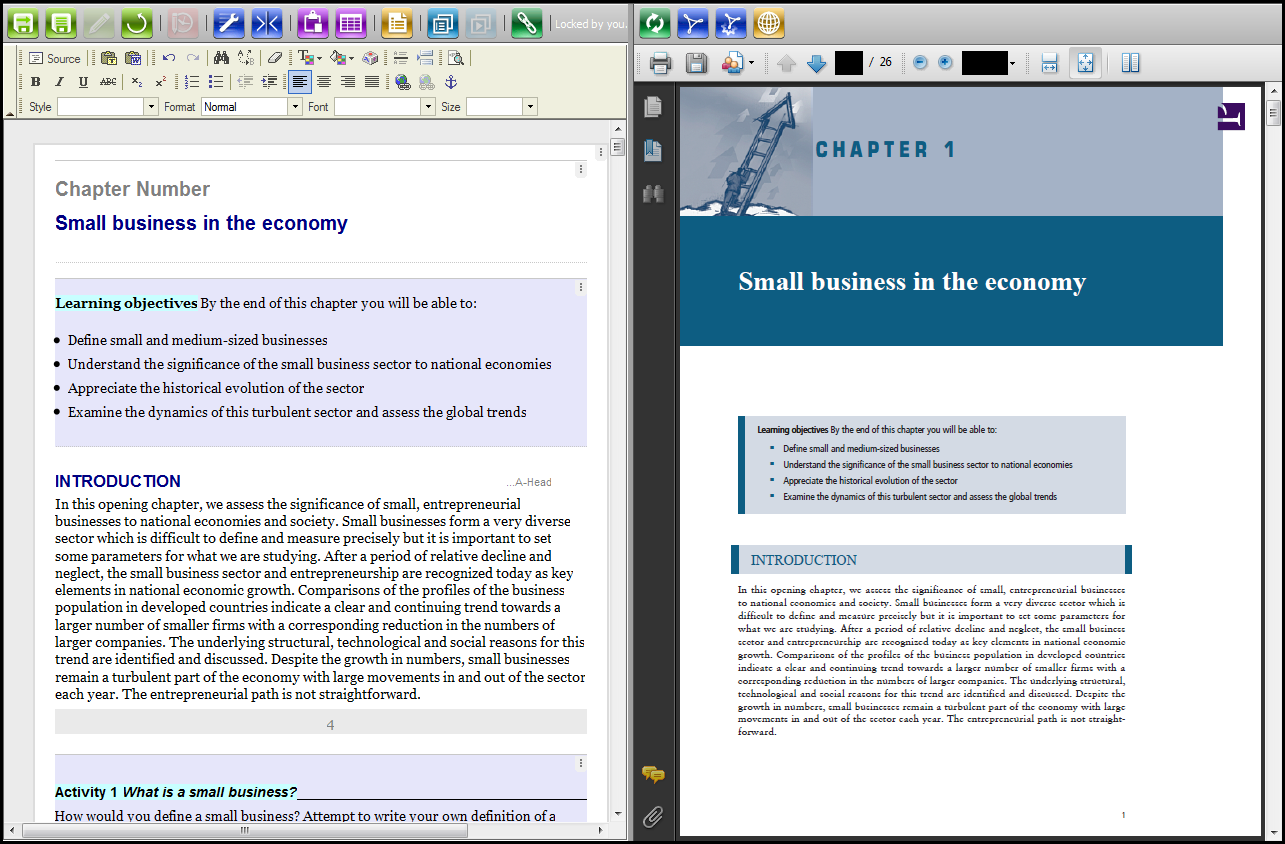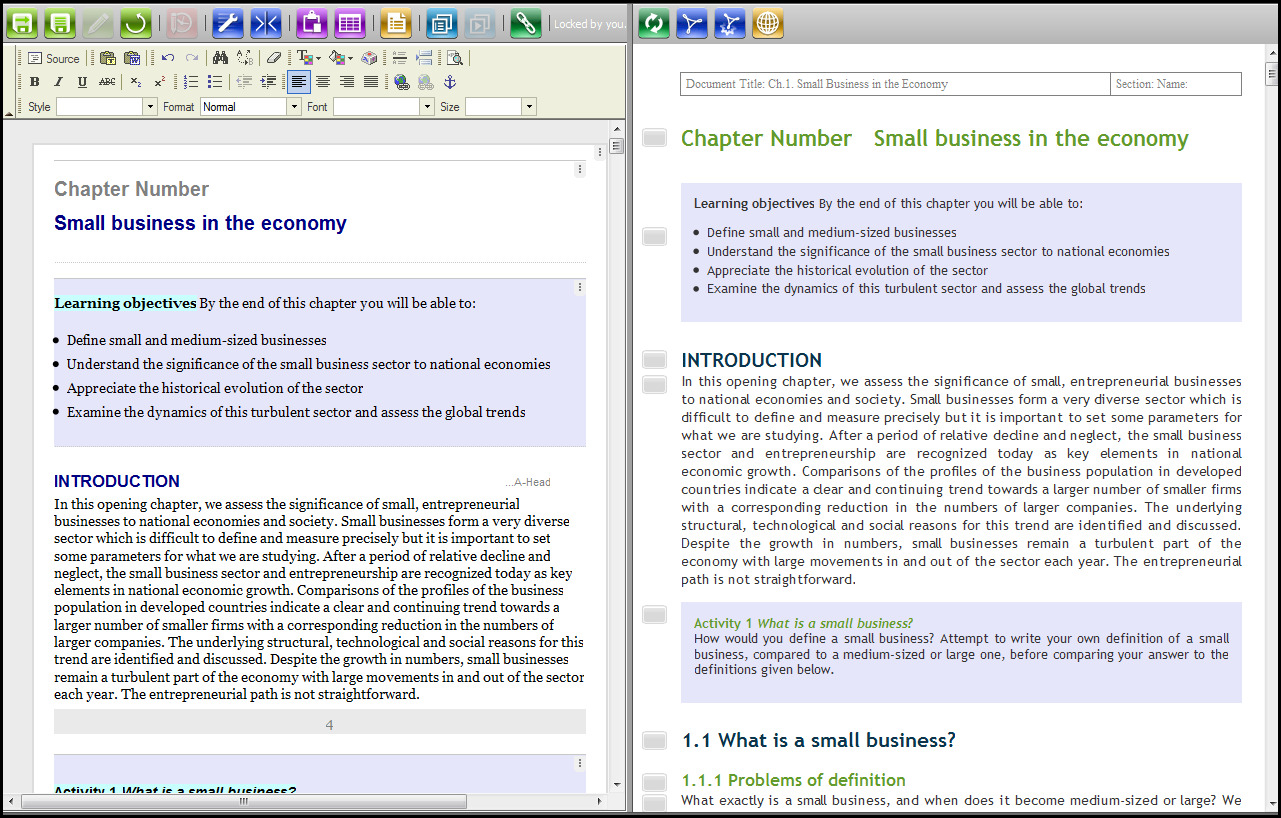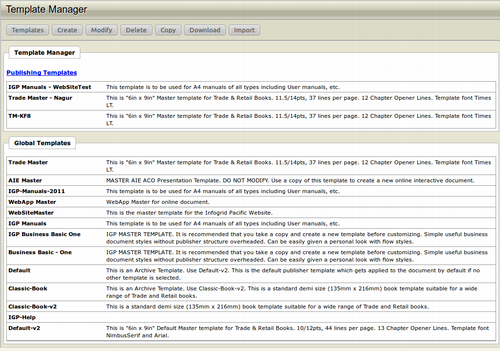5
IGP:Digital Publisher Templates
Introduction
- What are IGP:Digital Publisher Templates?
- The IGP:Digital Publisher Environments
- Writer environment
- Reader environment
- Print environment
- Formats on Demand (FOD) environment
- Package Generator environment
- The Template XHTML Components
- Document Templates
- Page Templates
- Content Block Templates
- The template manifest
- Creating Templates
- Uploading and Maintaining Templates
What are IGP:Digital Publisher Templates?
The template system in IGP:Digital Publisher is designed to be very flexible and open. It has the agility to address a very wide range of document types, content mediums, output formats and file packages; all from a single, standard, user assembled XHTML. The normal user doesn't need to know the details about the template system other than at the user interface level of selecting template and content block options.
IGP:Digital Publisher is designed to simplify XML based content production, not complicate it further. The illustration below shows the relationships between XML content structural components and the five primary work environments.

Figure 5-1IGP:Digital Publisher Template system exposed
One of the biggest challenges of working directly in XHTML/XML is how to hide the machine text from the user and provide the composer, author, or editor a reasonably familiar working toolset and environment where they can engage with the content and deliverable formats, rather than with technology.
In the Template System Exposed illustration, the blue blocks represent the XHTML template components that are used to assemble, modify and supply the very strict XHTML structure for any document. The red blocks are the visual and processing environments that the user interacts with to execute a wide range of output tasks on that XHTML.
The illustration shows that a single, dynamically assembled XHTML file is used to simultaneously feed multiple interactive environments which are always on and always available to do their task.
This makes IGP:Digital Publisher uniquely different from all other XML content production methods which rely on post processing. The XHTML is always in a state ready to generate any required output — in all formats — in near real time. This power can dramatically reshape publishing if it is used well. The concept of authoring, editing and composition integrated as simultaneous processes has never been available for formal document production. Organizations owe it to themselves to review the way they work to fully exploit the available power and advantages. IGP:Digital Publisher is not a new component in an old process, it completely redefines the business.
This is something no other tool can deliver. If the tools are used correctly, the result is increased quality, an extraordinary increase in productivity, and a dramatic lowering of production costs.
The IGP:Digital Publisher Environments
Default
Figure 5-2 Writer (left) and Print Live Preview (right) Environments showing the Writer and Print environment views of a text book.

Figure 5-3 Writer (left) and Reader Live Preview (right) Environments showing the Writer and Reader online environment views of a text book.
The Writer environment could just as easily have been created with a "semi-WYSIWIG" look and feel. This is typically preferrable for a Trade Publisher where the immediate output is probably only print and e-books (without a separate online presentation requirement).
Writer environment
Depending on work methodology and the content being worked on, the Writer CSS can be "semi-WYSIWIG", or represent a standard editing interface. This can be seen in the supplied setup presentation templates - Default and Classic Book. Classic Book uses the same Writer template as Default, while the Reader and Print templates create an output look.
Reader environment
This is also identical to the eBook format presentation, especially ePub, and allows the instant evaluation of the eBook deliverables, without actually generating them. Where Writer and Print may use the print font for presentation, Reader will use default device fonts.
Where content is being created specifically for online viewing the Reader presentation may be very different from the Writer and Print CSS. For example, Writer and Print may use serif fonts, while the Reader environment uses sans-serif fonts with very different title and header layouts.
Print environment
Print has its own special set of controls and processors as it has to handle strict pagination and layout rules. In some respects it is the most technical, but it is also largely transparent to the end users. In addition to layout, the print template has to handle a range of counters for page, chapter, header and figure number generation, movement of notes and footnotes, compiling and linking of the index, generation of running headers and footers, and a lot more.
Formats on Demand (FOD) environment
FOD has to take the sophisticated XHTML created through the Writer interface, and create packages for various formats, and usually, "dumb down" the XHTML for various target devices devices. In addition it has a number of processing options to allow eBook formats to be generated for both the preferences of individual publishers, and technical capabilities of various devices.
Package Generator environment
IGP:Digital Publisher is more than just print and e-books. It can be used to create highly interactive content for any purpose. This environment lets publishers take their content further and create new business on existing and old content. It also allows the creation of packages that in any other environment are expensive and difficult to create. It is for creating custom content packages that are not strictly formats. This includes:
FoundationXHTML Archive package. This is a comprehensive snapshot of all document components, packaged into a single file. This can optionally be the entire document, including revision history and deleted pages, or it can be just the active document.
SCORM package. This packages the content in conformance with SCORM 1.2 standard for shipping learning modules to LMS clients.
CD-ROM package. This packages the active document into an ISO package ready for CD-ROM/DVD distribution. It is probably most useful in education, but can contain linked files and other resources. There is no DRM on the CD-ROM.
ZIP package. This is identical to the CD-ROM package, but instead of an ISO image, it creates a simple ZIP package. This is ideal for distribution of help files and manuals where there is no online access. The content can also be put onto a USB memory device for distribution that way.
The Template XHTML Components
There are three primary structural components to any template, which defines the XML available for a document. These are: Document Templates, Page Templates and Content Block Templates. All template components can be created and modified by any user competent in XHTML and CSS development. Creating IGP:Digital Publisher templates is explained fully in the Technical Reference Manual.
Document Templates
There are three Document Templates, one for each of the primary visual environments. Document templates are relatively fixed and there is little modification or customization required as they are primarily pre-defined containers for the Page Templates.
Documents are assembled on demand from their various components for each environment.
Page Templates
Page in this context means a web presentation page not a print page. When used to create publisher document genres such as books or journals an IGP:Digital Publisher page is equivalent to a named document section, such as a chapter, appendix, or article. For other document genres such as manuals, marketing, and promotional material, the page could be a topic, sub-topic or any other named and controlled document structure.
Page Templates are relatively simple in XHTML terms, but very important in the system. They define the primary assembly structure of any document. A stack of Page Templates in a Document Template is a complete XHTML document.
The advantages of this section separation are many fold and perhaps more than any other factor enable new content management strategies. Here are just some of the advantages:
- Multiple collaborators working on a single document
- Sections maintain semantic value by definition and are valid process targets
- Sections can be authored, edited and composed independently
- Sections can be used independently for new business models
- Sections can be quickly and easily remixed into new documents
- Reusable library components can be mixed into documents
- Live Preview of sections is possible
Content Block Templates
Content Block Templates are used to structure the internal content of a document and provide the text level structures for detailed presentation. In addition to defined blocks such as "extract, notebox, figure", etc., they have properties that allow them to define different behaviours within the different environments.
Depending on the complexity of a document, Writer users will always interact with Content Blocks.
For example in an eBook or Online presentation, an image stays in the place it was inserted in the text, in the print book it may float page-top-next. Live preview allows the document editor or compositor to instantly view the results of complex Content Block movement.
Content Blocks get behaviour and presentation controls added to them in the Writer Environment. In print they have flow rules added, in eBooks and Online presentation, they are reshaped for browser or device limitations. They can even be removed or substituted with alternative blocks. For example the rights may have been obtained for a print product, but not for an electronic product. Therefore the Content Block will be shown in the print output, but not in the e-book output.
The template manifest
Any given IGP:Digital Publisher template must contain the following files:
| Writer Template | The document template framework for Writer | Mandatory |
| Reader Template | The document template framework for Reader | Mandatory |
| Print Template | The document template framework for Print | Mandatory |
| Writer Stylesheet | The primary writer interface CSS | Mandatory |
| Reader Stylesheet | The primary Reader interface CSS | Mandatory |
| Custom Stylesheet | The user managed Titles and Headers (TAH) customization stylesheet for Reader and e-book formats | Optional - recommended |
| Print Stylesheet | The primary Print Render interface CSS | Optional - required for print output |
| Custom Print Stylesheet | The user managed Titles and Headers (TAH) customization stylesheet for Print | Optional - recommended. Mandatory if IGP:Document Designer is used. |
| TOC Stylesheet | The Reader Table of Content presentation stylesheet | Mandatory - at least use Default |
| Content Templates | A zip file containing all the page templates for this presentation template | Mandatory |
| FO Processor | Reserved for installations that use XSL Formater instead of PrinceXML. Otherwise this is not used. | Optional |
| Template Sample Page | An optional information / tutorial page that demonstrates the use of this template for new end users. It can be as detailed as required depending on the complexity of the template. | Optional |
| Template Content Blocks | The configuration files to define custom Content Blocks available to any document using this specific template. | Optional. Global content blocks are always available. |
Table 5-1 Template files used by IGP:Digital Publisher.
Creating Templates
To create a template requires medium level HTML/CSS skills, (XSL knowledge may be an advantage for custom processors), and a thorough understanding of the IGP:FoundationXHTML structures and controlled vocabulary. Creating and modifying templates is an off-line activity and not handled in this topic.
Uploading and Maintaining Templates
IGP:Digital Publisher has a built-in Template Manager where you can create, modify and delete all template components. This is located in the Live Preview Pane tools menus.

Figure 5-4 Template Manager
